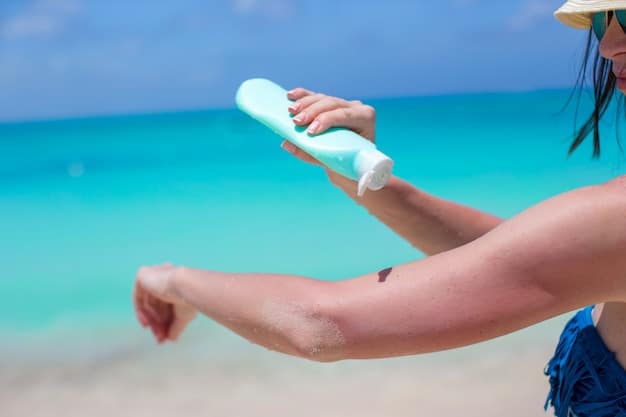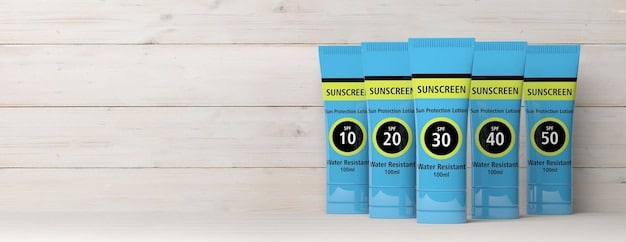Sunscreen Guide 2025: FDA Updates & Best Protection Tips

The Sunscreen Guide 2025 outlines the latest FDA regulations for sunscreen, offering expert advice on selecting the best sun protection products for your skin type and ensuring optimal safety while enjoying beach travel.
Planning a beach trip? The Sunscreen Guide 2025: Latest FDA Regulations and Best Protection Tips will help you navigate the latest updates and choose the best sunscreen for your needs, ensuring you stay protected under the sun.
Understanding the FDA’s New Sunscreen Regulations for 2025
The FDA is constantly updating its regulations regarding sunscreen to ensure consumer safety and product effectiveness. Staying informed about these changes is crucial for making the best choices for your skin.
In 2025, you can expect stricter guidelines on labeling, testing, and the allowed ingredients in sunscreens. These regulations aim to provide consumers with clearer information and safer products. Here’s what you need to know:
What the New Regulations Entail
The FDA’s regulations cover various aspects of sunscreen production and marketing. These include:
- Ingredient Safety: The FDA is reviewing the safety of certain sunscreen ingredients, particularly chemical filters like oxybenzone and octinoxate. These substances have raised concerns about potential hormone disruption and environmental impact.
- Broad Spectrum Protection: Sunscreens must offer broad-spectrum protection, meaning they protect against both UVA and UVB rays. The FDA is strengthening the requirements for broad-spectrum testing to ensure products meet these standards.
- SPF Labeling: The FDA is working to standardize SPF labeling, making it easier for consumers to understand the level of protection they are getting. There may be caps on the maximum SPF value that can be claimed.
- Water Resistance Claims: The FDA is tightening the rules about water resistance claims, ensuring that sunscreens truly maintain their effectiveness after swimming or sweating.
Being aware of these changes will help you choose sunscreens that not only protect your skin but also align with safety and environmental standards.
In summary, the FDA’s updated regulations are designed to provide better transparency, safety, and effectiveness in sunscreen products, giving consumers greater confidence in their sun protection choices.
Choosing the Right SPF: What Level Do You Really Need?
Selecting the right SPF (Sun Protection Factor) is essential for effective sun protection. The number represents how well the sunscreen protects you from UVB rays, which cause sunburn, skin damage, and increase the risk of skin cancer.
But how do you know which SPF level is right for you? Here’s a breakdown to help you make an informed decision:
Understanding SPF Levels
SPF measures the amount of time it would take for UVB rays to redden your skin compared to not using sunscreen. For example:
- SPF 15: Blocks about 93% of UVB rays.
- SPF 30: Blocks about 97% of UVB rays.
- SPF 50: Blocks about 98% of UVB rays.
While a higher SPF provides slightly more protection, no sunscreen can block 100% of UVB rays. It’s also important to note that the higher the SPF, the smaller the incremental benefit.
Factors to Consider
Several factors influence the SPF level you should choose:
- Skin Type: Fairer skin types are more sensitive to the sun and require higher SPF levels.
- Sun Exposure: If you’re spending prolonged periods outdoors, especially during peak sun hours (10 AM to 4 PM), opt for a higher SPF.
- Activity: If you’re swimming or sweating, choose a water-resistant sunscreen and reapply it frequently.
Ultimately, the best SPF is the one you’ll use consistently and correctly. Don’t rely solely on a high SPF; proper application and reapplication are key to effective sun protection.

In conclusion, selecting the right SPF involves understanding the level of protection provided, considering your skin type, and accounting for your sun exposure. Consistent and correct application is vital for maximizing the benefits of your chosen SPF.
Mineral vs. Chemical Sunscreen: Which Is Better for Your Skin?
When it comes to sunscreen, you’ll often encounter two main types: mineral (also known as physical) and chemical sunscreens. Both protect your skin from harmful UV rays, but they work differently and have different ingredients.
Understanding the differences between mineral and chemical sunscreens can help you choose the best option for your skin type and lifestyle.
Mineral Sunscreens
Mineral sunscreens use zinc oxide and titanium dioxide as active ingredients. These minerals create a physical barrier on your skin that reflects UV rays away from your body. Here are some key features:
- How They Work: Mineral sunscreens sit on top of the skin, providing a physical block against the sun.
- Ingredients: Typically contain zinc oxide and/or titanium dioxide.
- Pros: Generally considered safer for sensitive skin and less likely to cause allergic reactions. They are also reef-safe, making them a better choice for ocean swimming.
- Cons: Can sometimes leave a white cast on the skin, although newer formulations are designed to minimize this effect.
Chemical Sunscreens
Chemical sunscreens contain chemical filters that absorb UV rays and convert them into heat, which is then released from the skin. Key features include:
- How They Work: Chemical sunscreens absorb into the skin and absorb UV radiation as it penetrates the skin.
- Ingredients: Common chemical filters include oxybenzone, octinoxate, avobenzone, and octisalate.
- Pros: Tend to be thinner and easier to spread, and they don’t leave a white cast.
- Cons: Some chemical filters have raised concerns about hormone disruption and environmental impact, particularly on coral reefs.
Ultimately, the choice between mineral and chemical sunscreen depends on your skin type, sensitivity, and environmental concerns. Choose a product that you find comfortable and are likely to use consistently.
How to Properly Apply Sunscreen for Full Protection
Applying sunscreen correctly is just as important as choosing the right SPF and type. Even the best sunscreen won’t provide adequate protection if not applied properly.
Here’s a step-by-step guide to ensure you get full protection from the sun:
Step-by-Step Application Guide
- Apply Generously: Use about one ounce (a shot glass full) of sunscreen to cover your entire body.
- Don’t Miss Spots: Pay attention to often-missed areas such as the ears, back of the neck, tops of the feet, and hairline.
- Apply 15-30 Minutes Before Sun Exposure: This allows the sunscreen to bind to your skin.
- Reapply Frequently: Reapply every two hours, or immediately after swimming or sweating.
Common Mistakes to Avoid
Checking the Expiration Date
Sunscreen can expire. Check the expiration date printed on the bottle. Over time, the active ingredients can degrade, making the sunscreen less effective. If there’s no expiration date, discard the sunscreen three years after purchase.

Applying sunscreen correctly is crucial for ensuring full protection from the sun’s harmful rays. By following these guidelines, you can minimize your risk of sunburn, skin damage, and skin cancer.
Sunscreen for Specific Activities: Beach, Sports, and More
Different activities call for different types of sunscreen. Whether you’re hitting the beach, playing sports, or simply going for a walk, choosing the right sunscreen can make a big difference in your protection and comfort.
Here’s a guide to selecting sunscreens for various activities:
Beach Days
When spending the day at the beach, consider the following:
- Water Resistance: Choose a water-resistant or water-proof sunscreen, but remember to reapply every two hours or immediately after swimming or toweling off.
- Broad Spectrum: Ensure it offers broad-spectrum protection to shield against both UVA and UVB rays.
- Reef-Safe: Opt for a mineral sunscreen that is reef-safe to protect marine ecosystems.
Outdoor Sports
For activities like running, hiking, or playing sports, look for:
- Sweat Resistance: Choose a sunscreen that is sweat-resistant to prevent it from running into your eyes.
- Lightweight Formula: Opt for a non-greasy, lightweight formula that won’t weigh you down.
- High SPF: Select a high SPF to provide maximum protection during prolonged sun exposure.
Everyday Use
For daily activities, such as commuting or running errands:
- Broad Spectrum: Choose a sunscreen with broad-spectrum protection and an SPF of at least 30.
- Lightweight and Non-Greasy: Look for a formula that is easy to apply and won’t clog pores.
- Wearable Under Makeup: Opt for a sunscreen that can be worn comfortably under makeup.
Choosing the right sunscreen for your specific activities ensures that you’re adequately protected while remaining comfortable and confident in your skin.
Common Sunscreen Myths Debunked
There are many misconceptions about sunscreen that can lead to improper use and inadequate protection. Separating fact from fiction is essential for staying safe in the sun.
Here are some common sunscreen myths debunked:
- Myth: Darker Skin Doesn’t Need Sunscreen
- Myth: Applying Sunscreen Once a Day Is Enough
- Myth: Makeup with SPF Is Sufficient
- Myth: You Can’t Get Sunburned on a Cloudy Day
Fact: Everyone, regardless of skin color, can be affected by UV damage. Melanin offers some natural protection, but it’s not enough to prevent sunburn, premature aging, and skin cancer.
Fact: Sunscreen should be reapplied every two hours, or immediately after swimming or sweating. Its effectiveness decreases over time, especially with physical activity.
Fact: While makeup with SPF is better than nothing, it typically doesn’t provide enough coverage to offer adequate protection. Use a dedicated sunscreen under your makeup.
Fact: UV rays can penetrate clouds, so you can still get sunburned on overcast days. Always apply sunscreen, regardless of the weather.
By dispelling these common myths, you can ensure that you’re using sunscreen correctly and effectively to protect your skin from sun damage.
| Key Point | Brief Description |
|---|---|
| ☀️ FDA Regulations | Stay updated on new FDA rules for sunscreen safety and effectiveness. |
| 🧴 Choosing SPF | Select the right SPF based on skin type and sun exposure, applying generously. |
| 🌿 Mineral vs. Chemical | Understand differences to choose what suits your skin & environment. |
| 🏖️ Activity-Specific | Use sunscreen appropriate for swimming, sports, and daily use. |
Frequently Asked Questions (FAQ)
▼
The key changes include stricter guidelines on ingredient safety, especially for chemical filters, enhanced broad-spectrum protection requirements, standardized SPF labeling, and more rigorous water resistance claims.
▼
Reapply sunscreen every two hours, or immediately after swimming, sweating, or toweling off. Even water-resistant sunscreens lose effectiveness, so regular reapplication is vital.
▼
Yes, mineral sunscreens are generally better for sensitive skin. They contain zinc oxide and titanium dioxide, which are less likely to cause allergic reactions compared to chemical filters.
▼
Makeup with SPF is not sufficient for full sun protection. It often doesn’t provide enough coverage, so use a dedicated sunscreen under your makeup for adequate protection.
▼
For outdoor sports, choose a sunscreen that is sweat-resistant, lightweight, and has a high SPF. Look for non-greasy formulas that won’t run into your eyes during physical activity.
Conclusion
Staying informed about sunscreen regulations and best practices is crucial for protecting your skin and enjoying your time in the sun safely. By following the tips in this guide, you can make informed choices and ensure you’re using sunscreen effectively.





